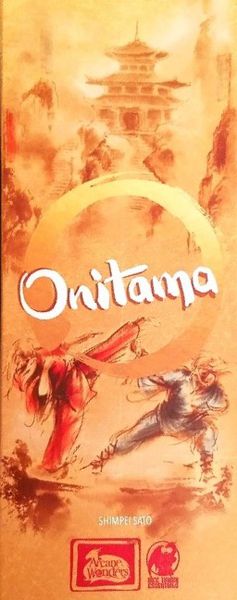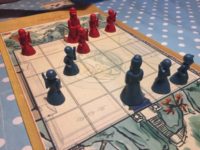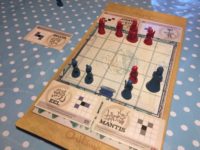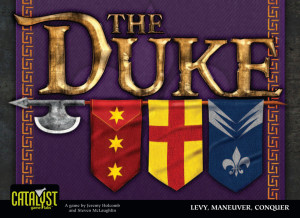- Learning time
- 10 minutes
- First play time
- 30 minutes
Onitama
Designed by: Shimpei Sato
Onitama is a two-player ninja battle to the death. Although, not to oversell the drama, the game is less high-kicking and more cerebrally chess-like than the description implies.
Two groups of warriors face off across the 5×5 grid on a roll-out mat; each side comprised of a Master and four apprentices, with the goal to either eliminate your opponent’s Master (The Way of the Stone) or have your own reach the far side of the grid (The Way of the Stream).
How you do this is the game’s central – and rather clever – conceit. In each game, a mere five movement cards are dealt to the table: two for each player and one to the right of the starting player. The movement cards represent the options for where one of your pieces can move: a black square shows the starting position of the chosen piece and the shaded squares the choices of where it can go. Having chosen and moved one of your pieces, you slide the card to the left of the board and replace it with the ‘spare’ card on your right. Your opponent now repeats that process; activating a movement card and replacing it with the card you used.
What this means, then, is that both players are utilising the same five cards as they rotate around the table, with a chess-style capture rule on the board: land on an opponent’s piece, and it’s instantly out of the game. This limiting of options in each game might sound stifling, but what’s key here is that you can see what options your opponent has, you can see what card you’re receiving next, and what card they are receiving next too. Factor all that in – you need to factor that in, because it kind of is the game – and the limiting of options makes a great deal of sense.
The guru's verdict
-
Take That!
Take That!
Well, it's a fight to the death...
-
Fidget Factor!
Fidget Factor!
There can be lulls, because despite the dearth of choices on anyone's current turn, the game rewards a bit of thinking ahead.
-
Brain Burn!
Brain Burn!
The rules are light - the challenge is how you make best use of the cards; not just on your current turn but with a bit of forethought about what cards are coming your way soon. There's even a bit of brinkmanship over which card your opponent will pass, as they may see one helps you more than the other...
-
Again Again!
Again Again!
There are a number of movement cards to give the game a lot of variety in how it plays.













Sam says
There are exceptions (we loved Tak and enjoyed The Duke) but generally a two-player abstract battle isn't something me, my family or pals who regularly play games seek out. Purely subjectively I like a bit more theme, a bit more detail and just a bit more going on. But pushing that personal taste to one side I appreciate the elegance of Onitama; it's remarkable how much game is condensed into a bunch of rules you can learn in five minutes. The first play didn't shine for us as the movement cards can feel so restrictive. But playing it more we realised that the pattern the players create with the selection and swapping of movement cards is as much the game was what happens on the board. The caveat I would add is that the best experience relies on at least one player being aggressive and going on the offensive - it's very easy to end up in a kind of dance-of-avoidance if both of you linger back, waiting for the other to act. But that aside, this is a neat game.